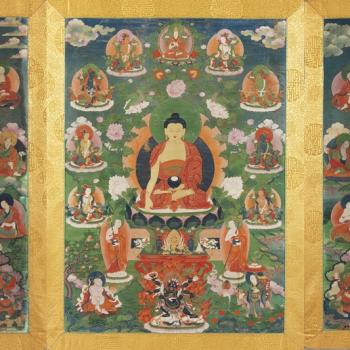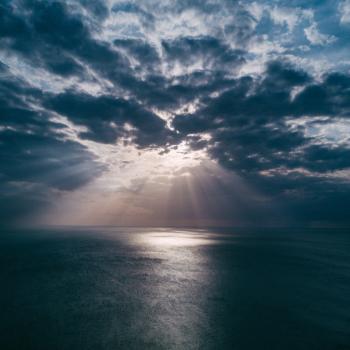Some of the best known chaplain tales come from World War II. Father Francis Sampson, who was eventually to become the Army's chief of chaplains, parachuted into Normandy on D-Day 1944 with the 101st Airborne Division. Captured by the Germans and nearly executed out of hand, he survived to minister to soldiers throughout the campaigns of 1944, until he was captured again during the Battle of the Bulge in December. While incarcerated in a Stalag near Berlin, he insisted on being held with the enlisted men, whose conditions were worse than those afforded the officers in the POW camps.
Many are familiar too with the story of USAT Dorchester, a troop transport ship, and the "Four Chaplains" who went down with it when it was torpedoed by a German U-boat off Greenland in February 1943. As Dorchester sank into the dark, frigid Atlantic, the four chaplains on the ship—a Jewish rabbi, two Protestants, and a Catholic priest—assisted hundreds of desperate men in donning lifejackets and getting up on deck. Praying with and comforting all, irrespective of religion or denomination, the chaplains did everything they could to save their shipmates, in the end putting their own lifejackets on other men.
Those who had been fortunate enough to reach lifeboats struggled to distance themselves from the sinking ship, lest they be pulled beneath the ocean swells by the chasm created as the transport slipped into a watery grave. Then, amid the screams of pain and horror that permeated the cold dark night, they heard the strong voices of the Chaplains. "Shma Yisroel Adonai Elohenu Adonai Echod." "Our Father, which art in Heaven, Hallowed be Thy name. Thy kingdom come, Thy will be done."
Modern chaplains like Chaplain (Captain) Earl Weigelt, of the Maine National Guard, continue the tradition of "standing in the gap" for their troops. But in America, chaplains have also had a unique association with one of the most fundamental elements of our national character: religious liberty. That association started in the earliest days of the chaplaincy.
The Army Chaplain Corps was born with the American Revolution, from an authorization by the Continental Congress on July 29, 1775. The tiny Continental Navy was awarded an authorization for chaplains on November 28, 1775. Chaplain David Avery, one of the best known clerics of the period, set the standard for the U.S. military chaplaincy with his service at the battle of Bunker Hill. On Christmas Eve, 1776, he crossed the Delaware River with George Washington to participate in the battle of Trenton. Avery was said to be "everything [Washington] wanted in a chaplain," frequently riding at his side and taking meals with him.
Given the significance of religious liberty to the Americans' revolutionary cause, it is not surprising that the clergy, including chaplains, were key philosophers and advocates of the revolution. They were, in a sense, living out the very purpose of the quest for liberty. Monarchists of the period called them the "black regiment" of the revolution—a reference to their black clerical robes—and many stories arose around their exploits in inciting the colonials and encouraging the ragtag army. This characterization, well known at the time of the revolution, has become the subject of study again in recent years, from popular histories like A. J. Langguth's 1989 book Patriots: The Men Who Started the American Revolution to academic treatments.
David Barton, founder of the "Wall Builders" organization featured on the Glenn Beck TV program, is probably today's best-known popular historian of the "Black-Robe Regiment." He draws on a legacy of period documentation and historical writing that demonstrates the pervasiveness of this theme in America's early concept of itself. It is uniquely fitting, therefore, that one of the best "chaplain stories" from World War II evokes this essential American theme.





